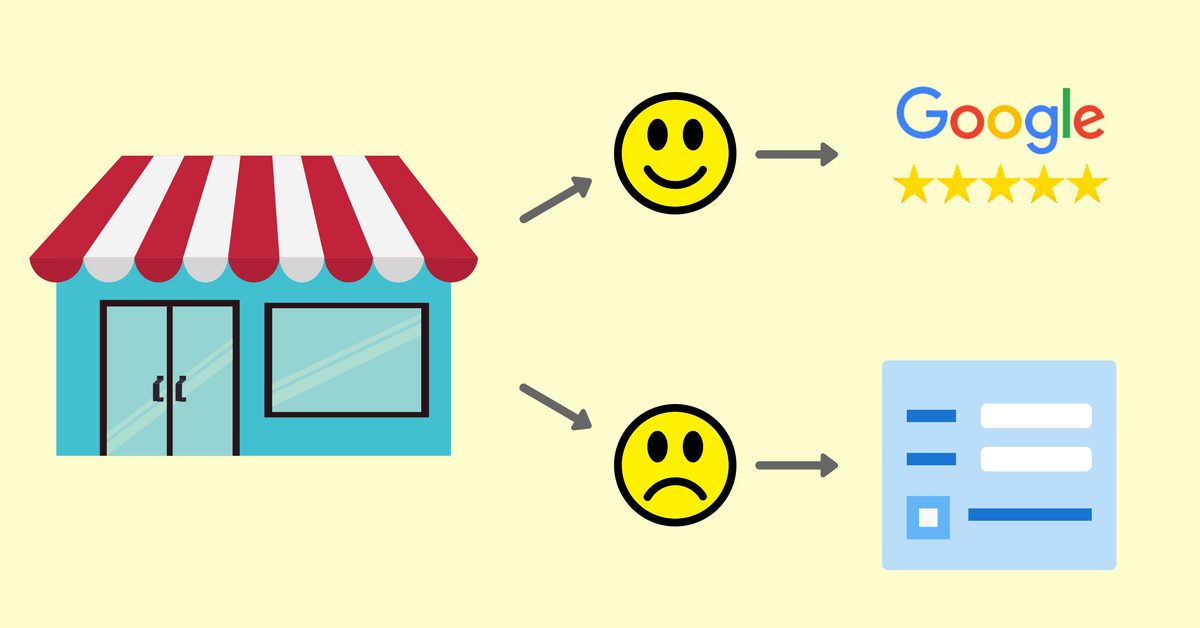Unlike Yelp, Google doesn’t mind if you ask for reviews. But you need to follow their terms of service if you plan to ask for reviews. Google recently updated their terms (check them out here) and it seems that you can no longer use a review funnel. A review funnel sends a customer to Google if they give you positive feedback and then to an internal form or another direction if they give you negative feedback. It would look something like this:

[Our software does use a review funnel for feedback but since this Google update, we have updated our software to adhere to Google’s terms. I’ll explain this more later on in the post.]
The new line Google added is:
“Don’t discourage or prohibit negative reviews or selectively solicit positive reviews from customers.”

It’s a little vague but I’ll give you our understanding of it.
“Don’t discourage or prohibit negative reviews…”
If you use a review funnel, then you are prohibiting negative reviews from customers. You are “funneling” customers one way so they don’t see your review links.
A simple remedy to this is that you can continue to use a review funnel, but give the customer an option to leave the business feedback on an internal form AND also give them the option to post a review online about their negative experience.
If a happy customer and unhappy customer can easily access your review links then you should be good. If a customer is unhappy, including a form so they can leave additional feedback does not seem to be against Google’s policy (as long as your review links are present). I don’t think Google would penalize you for making your business a better place by asking for more information from an unhappy customer. That’s what good customer service is!
“…selectively solicit positive reviews from customers”
This line is a bit trickier. We had a feature called Gboost. It would detect a gmail address and then send anyone that clicked 4-5 stars to Google. It worked well.
But we have removed that feature because we feel that it is selectively trying to get positive reviews from happy customers. It’s a bummer because we were super proud of that feature but we want to adhere to Google’s policy and don’t want our users to get in trouble with the big G.
Does selectively soliciting reviews from happy customers mean that asking a happy customer for a review is against their policy?
It could be but again, it’s a bit unclear. The best solution is to ask ALL of your customers about their experience, good or bad. After a customer uses your business ask them for a review. Shoot them an email, text or ask them in person. But ask them ALL.
Will Google Penalize You?
Google takes their reviews very seriously. There is a large review platform (which I will not mention), that was sending their users customers to a prefilled 5 star review auto-generated review box. Google noticed this and removed their users customer reviews for anyone coming from their link. They are pretty big and have a big chunk of users.
The new term wouldn’t be easy to detect but if it was manually flagged and reported to Google, they could potentially remove all of a businesses reviews. I would not recommend you take a chance on gaming the system. After this announcement most review tools are fixing their system like we did with ours. There will still be a few that don’t so use caution if you decide to use them.
How We Fixed The Issue & Why We Agree
We now display a businesses review links on our feedback form for unhappy customers. We do not discriminate if you are a happy or unhappy customer. And honestly, we feel better about this now.

We created our tool to get feedback about your business and help get reviews online. We kind of went along with the trend by not showing review links on the negative feedback page but never felt good about that. I can see where Google is coming from as that type of review funnel will greatly help prevent negative reviews.
Will some customers continue to leave negative feedback?
Sure, some might.
But most pissed off customers just want a way to vent. They want to tell the business that they are unhappy and that’s what ReviewRail is for. If they are really mad, ReviewRail or any other review tool out there isn’t going to stop them from posting a bad review online. It’s easy to find a business online and bash them on Google, Yelp, FB and dozens of other places.
A bad review isn’t the end of the world. We wrote a post on how to respond to negative reviews. Check it out. If the response is timely and appropriate, it may even attract customers because of the professionalism a business went about in responding to a bad review.
I read reviews like a maniac for local businesses I use. Most of the time it’s for food (because food is awesome) but I look at reviews for all businesses. And I’m happy to go with a business with bad reviews, as long as they handle it the right way.
Steps To Take
FOR BUSINESSES: Make sure you adhere to these new rules. If you use a review tool (hopefully ours! :)) check that they are following Googles new review terms. Also make sure to ask all customers for reviews, happy and unhappy.
FOR AGENCIES: Check that your clients are not using a tool against Googles TOS. We are working on a white-label version of ReviewRail so if you are interested in that, jump on the waiting list below.
AGENCY WAITING LIST: You’ll get a discount plus some extra accounts. Click here to learn more and get on the waiting list.
If you have any questions or comments about the new terms, post them below!

 Hey there. I want to explain why your business NEEDS citations and what they are. My name is Stephen Alberts and I’m the creator of ReviewRail, customer feedback software. I’ll go over why you need these and also have a GOLDEN NUGGET tip for you that could help your website rankings!
Hey there. I want to explain why your business NEEDS citations and what they are. My name is Stephen Alberts and I’m the creator of ReviewRail, customer feedback software. I’ll go over why you need these and also have a GOLDEN NUGGET tip for you that could help your website rankings!
